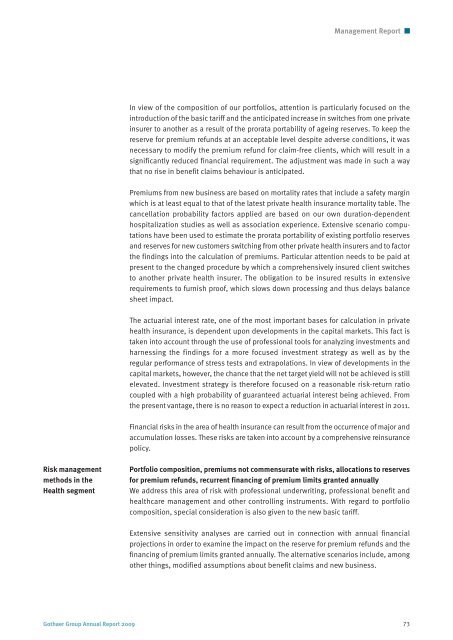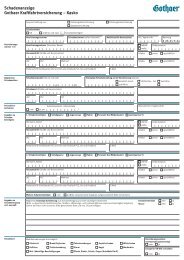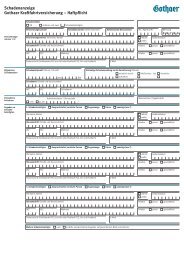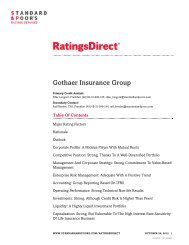01 Gothaer Konzern_E_09_Umschl - Gothaer Allgemeine ...
01 Gothaer Konzern_E_09_Umschl - Gothaer Allgemeine ...
01 Gothaer Konzern_E_09_Umschl - Gothaer Allgemeine ...
Create successful ePaper yourself
Turn your PDF publications into a flip-book with our unique Google optimized e-Paper software.
Risk management<br />
methods in the<br />
Health segment<br />
Management Report<br />
In view of the composition of our portfolios, attention is particularly focused on the<br />
introduction of the basic tariff and the anticipated increase in switches from one private<br />
insurer to another as a result of the prorata portability of ageing reserves. To keep the<br />
reserve for premium refunds at an acceptable level despite adverse conditions, it was<br />
necessary to modify the premium refund for claim-free clients, which will result in a<br />
significantly reduced financial requirement. The adjustment was made in such a way<br />
that no rise in benefit claims behaviour is anticipated.<br />
Premiums from new business are based on mortality rates that include a safety margin<br />
which is at least equal to that of the latest private health insurance mortality table. The<br />
cancellation probability factors applied are based on our own duration-dependent<br />
hospitalization studies as well as association experience. Extensive scenario computations<br />
have been used to estimate the prorata portability of existing portfolio reserves<br />
and reserves for new customers switching from other private health insurers and to factor<br />
the findings into the calculation of premiums. Particular attention needs to be paid at<br />
present to the changed procedure by which a comprehensively insured client switches<br />
to another private health insurer. The obligation to be insured results in extensive<br />
requirements to furnish proof, which slows down processing and thus delays balance<br />
sheet impact.<br />
The actuarial interest rate, one of the most important bases for calculation in private<br />
health insurance, is dependent upon developments in the capital markets. This fact is<br />
taken into account through the use of professional tools for analyzing investments and<br />
harnessing the findings for a more focused investment strategy as well as by the<br />
regular performance of stress tests and extrapolations. In view of developments in the<br />
capital markets, however, the chance that the net target yield will not be achieved is still<br />
elevated. Investment strategy is therefore focused on a reasonable risk-return ratio<br />
coupled with a high probability of guaranteed actuarial interest being achieved. From<br />
the present vantage, there is no reason to expect a reduction in actuarial interest in 2<strong>01</strong>1.<br />
Financial risks in the area of health insurance can result from the occurrence of major and<br />
accumulation losses. These risks are taken into account by a comprehensive reinsurance<br />
policy.<br />
Portfolio composition, premiums not commensurate with risks, allocations to reserves<br />
for premium refunds, recurrent financing of premium limits granted annually<br />
We address this area of risk with professional underwriting, professional benefit and<br />
healthcare management and other controlling instruments. With regard to portfolio<br />
composition, special consideration is also given to the new basic tariff.<br />
Extensive sensitivity analyses are carried out in connection with annual financial<br />
projections in order to examine the impact on the reserve for premium refunds and the<br />
financing of premium limits granted annually. The alternative scenarios include, among<br />
other things, modified assumptions about benefit claims and new business.<br />
<strong>Gothaer</strong> Group Annual Report 20<strong>09</strong> 73

















